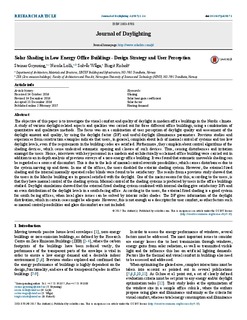| dc.description.abstract | The objective of this paper is to investigate the visual comfort and quality of daylight in modern office buildings in the Nordic climate. A study of various daylight-related aspects and qualities was carried out for three different office buildings, using a combination of quantitative and qualitative methods. The focus was on a combination of user perception of daylight quality and assessment of the daylight amount and quality, by using the daylight factor (DF) and useful daylight illuminance parameters. Previous studies and experiences from construction examples indicate that users, in general, complain about lack of manual control of systems and too low daylight levels, even if the requirements in the building codes are satisfied. Furthermore, they complain about control algorithms of the shading devices, which cause undesired automatic opening and closure of such devices. Thus, causing disturbances and irritation amongst the users. Hence, interviews with key personnel in a modern and architecturally acclaimed office building were carried out in addition to an in-depth analysis of previous surveys of a zero-energy office building. It was found that automatic moveable shading can be regarded as a source of discomfort. This is due to the lack of manual-control override possibilities, which causes disturbances due to the system moving up and down. In one of the offices, the users disabled the exterior shading system. However, the external fixed shading and the internal manually operated roller blinds were found to be satisfactory. The results from a previous study showed that the users in the Marche building are in general satisfied with the daylight. One of the main reasons for this, according to the users, is that they have manual control of the shading system. Manual control of the shading systems is preferred by users in the office buildings studied. Daylight simulations showed that the external fixed shading system combined with internal shading give satisfactory DFs and an even distribution of the daylight levels in a south-facing office. According to the users, the external fixed shading is a good system for south facing offices, when local glare issues can be solved by interior roller shades. The DF gives information of the daylight distribution, which in certain cases might be adequate. However, this is not enough as a descriptor for user comfort, as other factors such as manual control possibilities and glare discomfort are not included. | nb_NO |

